Saturday, 29 November 2008
More Depth of Field Teach Ins
Monday, 24 November 2008
Whet Plent Ees It?
Later on, I would encounter it once in a rare while. This is one from Thailand, captured on film.
 |
| From Plants and Flowers |
Saturday, 22 November 2008
Beauty is in the eye of the beholder
 |
| From Spring in Melbourne |
Sunday, 16 November 2008
Radiant smiles
Tuesday, 4 November 2008
Major Tom calling
Vignetting Flowers
Fun with an older digital camera
The Harley shot - I'm amazed at the clarity and detail. Hint: It's not monochrome.
Waiting for the ferry at Southbank - this one is Monochrome - converted in Mediachance Paintbrush, framed with the AAA Frames Photoshop plugin, resized using Bilinear 2-Pass and sharpened with USM defaults.
Wednesday, 22 October 2008
Mastering the UWA
I came across Petteri Sulonen's article - Mastering Wide Angle. That woke me up a bit.
On focussing, he says:
- If your camera is even slightly out of the horizontal, verticals will converge
- "Short focal lengths have lots and lots of depth of field." They sure do. However, the other side of the coin is that the attendant wide scenes tend to be very deep, so you're going to need all of it, and more, if you want to keep everything sharp - The trouble is that while there's lots of DOF, the scenes are very deep, and wide-angle scenes tend to draw the eye to "wander" around the frame, which means it'll eventually land on something that's not critically sharp. A second complication is that auto-focus really doesn't work that well with wide-angle. Especially with the shorter, darker lenses hyperfocal distance wide-open is really quite close. Moreover, objects even a few meters away may be quite small in the frame, while the AF sensors are quite large. This means that AF will have real trouble latching onto anything more than a few meters away.
- you as the photographer have to take flare into consideration anyway; either work it into the composition or try to minimize it while composing.
- Expose for maximal dynamic range, then correct in post-processing.
- Stop down as far as you can.Identify the visual center, and focus on that.
- If you want infinity to be sharp, focus on infinity.
- If you have to choose, focus behind rather than in front of the subject.
Monday, 20 October 2008
Earl Klugh makes a comeback

Earl was there throughout the 1980s, 1990s but I lost interest because his albums became too layered and formulaic. This year, 2008, he comes back after 9 years away in The Spice Of Life.
Visiting his website, I just heard Angelina, a favourite of Lim Kang's
myFox Boston has a video clip of an interview. He plays Canadian Sunset - something I remember of the music my Dad had on his vinyl LPs. One thing with Earl and Lee, they seem to have both lost their hair and they both had hair on their 1980 albums.
There is a forum on his website with video links. Some of them:
- Heartstring - that must be the most worn out track on my vinyl and my cassette (remember those?) - memories of Eugene, Taman Seputeh, Mum and Dad, driving in K.L in the Colt and the Cordia.
- The Girl from Ipanema
Thursday, 16 October 2008
Birdland
Tuesday, 14 October 2008
This the season for white petals
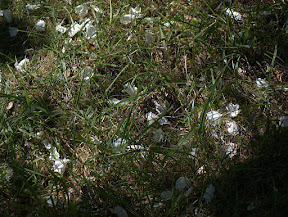 |
| From Plants and Flowers |
Little buzzing things alight
 |
| From Plants and Flowers |
We think it's a lazy day, but they toil as well
 |
| From Plants and Flowers |
JPEG Browsing / Viewing - PhotoMesa
Monday, 13 October 2008
Brain a bit tired
Then, there's Is It You?
Lee's inspired a fair number of artists. Have a look at the seriousness of the Phillipino, Lee in Co-E-sion
Even Mas Que Nada inspires him
I've been a Spyrogyra fan since their first album. Here they are, years ago in Morning Dance and more recently at Jak Jazz. They've lost the frenetic percussionist. Here's one I am not familiar - Cayo Hueso:
Lee Ritenour likes Brazilian music. Here he is is with Ivan Lins
I first heard George Benson's version of Dinorah. Here is Ivan's.
Speaking of George, I didn't know he did a set with Carlos Santana
Long ago, there was Mountain Dance. It's still a classic.
For something really new, here's Brian O'Neal with Mesmerised
Friday, 10 October 2008
When computer tech and light tech combine....
We have digital imaging. People often talk about JPEGs being 8bit and ask whether a 14bit RAW is better than a 12bit RAW. Or whether sRGB vs Adobe RGB compares with 24bit colour rendering.
Essentially though, digital capture, storage and rendering hasn't anything to do with the how light and colour looks - they overlap in the fact that one mechanism leads to another but they are different facets to the image.
sRGB - is a definition of colour space. Colour Spaces are all about the light, colour and measuring this.
8 bit - Bits are a computer concept to describe counting and numbers used in binary computers.
The two concepts, sRGB and number of Bits describe different things.
There are several display technologies - LCD panels, Plasma Panels and CRTs.
LCD Panel Types
In terms of LCD panels, the electronics and the panels vary. There are TN panels, S-IPS panels, VA panels. Xbit details LCD Monitor Parameters and Characteristics. Anandtech lists some selection criteria.From Anandtech:
"Almost all LCDs today are 6-bit or 8-bit LCDs. This means that each subpixel - Red, Green, and Blue - can display one of 2 to the n shades where n represents the number of pixels. A typical 8-bit LCD can produce 256 shades per pixel, or 16.7M color combinations. A 6-bit LCD panel can display 64 shades per subpixel, and since there are three subpixels per pixel, the monitor can display 262,000 color combinations per pixel"
From wikipedia:
"For colour representation many panels use 6 bits per colour, instead of 8, and are consequently unable to display the full 24-bit truecolor (16.7 million colour shades) available from modern graphics cards. These panels can display interpolated 24-bit color using a dithering method which combines adjacent pixels to simulate the desired shade. They can also use FRC (Frame Rate Control), which quickly cycles pixels over time to simulate a given shade. These color simulation methods are noticeable to most people and bothersome to some[citation needed]. FRC tends to be most noticeable in darker tones, while dithering appears to make the individual pixels of the LCD visible. Overall, color reproduction and linearity on TN panels is poor."
How do you find out what type the LCD panel you are interested in is? Try TFTCentral and Flatpanels.dk A concise list and summary of features is at Hardforum.
Gamut of backlights
In addition to the different panel substrate technologies, these panels have to be lit - thus they can choose to use different bulbs (lights).From wikipedia:
"Shortcomings in display color gamut (often referred to as a percentage of the NTSC 1953 color gamut) are also due to backlighting technology. It is not uncommon for displays with CCFL (Cold Cathode Fluorescent Lamps)-based lighting to range from 40% to 76% of the NTSC color gamut, whereas displays utilizing white LED backlights may extend past 100% of the NTSC color gamut – a difference quite perceivable by the human eye."
Monday, 6 October 2008
You hear about Henri Cartier Bresson a lot
The Photograph Takes Me
The Stages of a modern Photographer
Stage 0: Which camera gives me the best IQ? Guys! Recommend me a camera! Anybody?
Stage 0.1: I'm serious, which camera gives me the best IQ, cut out the BS about the skill of the photographer.
Stage 0.2: I'm gonna buy a D3 or a 1D, your camera sucks. (See attached sample lab photos of paperclips shot with a D3 / 1D vs your crummy camera.)
Stage 0.3: Why does everything look blurry? What does DOF mean?
Stage 0.4: Why is everything so white (or black?). What do you mean the camera doesn't fix things if I set the dial to "M"?
Stage 1: Why waste time shooting RAW? JPEG is lovely!
Stage 1.1: Aah, wasted all this time shooting JPEG. RAW rocks!
Stage 1.2: Help! My prints come out too dark! What do you mean I have to spend more money on a spider? What's a helicopter and a spider got to do with this?
Stage 1.3: RAW sucks! You know how much time I'm spending on the computer?
Stage 1.4: APS-C sucks. Go full frame! And don't let me get started on Four Thirds. Just look at the achievable low light high ISO noise and the MTFs.
To be continued...
Saturday, 4 October 2008
Dreaming in Melbourne
With a field of Dreamers do they dream all the same dream or do they dream contentiously?
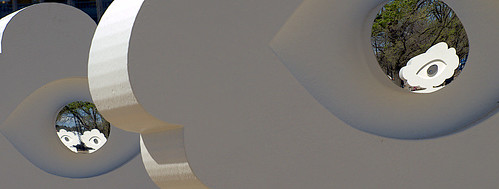
Do we dream in the sun or only in the dark?
And the perennial, do you dream in colour

or in black and white
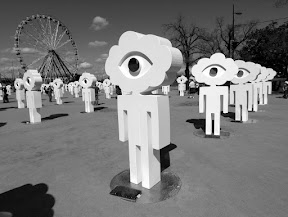 |
| From Dreamers |
Thursday, 2 October 2008
UWA is not for getting it all in
Here's what Ken Rockwell says about this kinda lens.
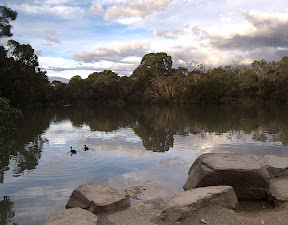 |
| From Blackburn Lake |
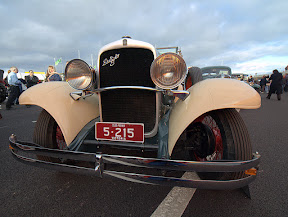 |
| From Zuiko Digital 7-14mm |
The one below is actually of a smal sportscar, a SMART. I wanted to emphasise the bulge of the bonnet.
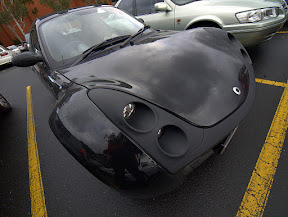 |
| From Zuiko Digital 7-14mm |
This last one is scenic and calm and lonely to me. There is no particular shape or geometric emphasis of the bench or the buildings. But the sweep of the foreground grass strikes me as an emphasis. Because it is so quiet an emphasis, it is almost a bow-tie shot.
 |
| From Zuiko Digital 7-14mm |
Saturday, 27 September 2008
Conspiring Moments
Friday, 26 September 2008
The Martial Arts Series
Wednesday, 24 September 2008
The content rules
Friday, 19 September 2008
JPEG Quality
Thursday, 18 September 2008
A Fascination for Benches
Topical
 |
| From Odds and Ends |
Tuesday, 16 September 2008
Going Chinese
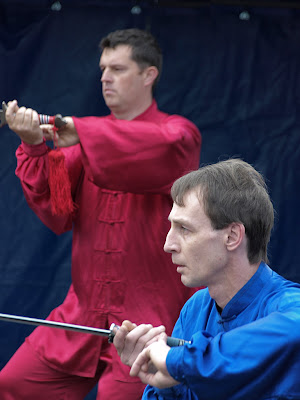 |
| From People |
Friday, 12 September 2008
Empatico
 |
| From Melbourne |
This scene was very much in the air when these girls came with their point and shoot flash.
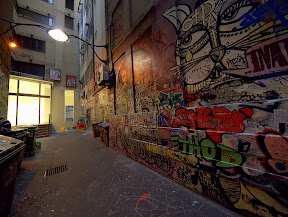 |
| From Melbourne |
The Beemer in the alley was mysterious as well.
 |
| From Melbourne |

